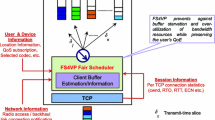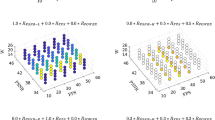Abstract
Video processing in software is often characterized by highly fluctuating, content-dependent processing times, and a limited tolerance for deadline misses. We present an approach that allows close-to-average-case resource allocation to a single video processing task, based on asynchronous, scalable processing, and QoS adaptation. The QoS adaptation balances different QoS parameters that can be tuned, based on user-perception experiments: picture quality, deadline misses, and quality changes. We model the balancing problem as a discrete stochastic decision problem, and propose two solution strategies, based on a Markov decision process and reinforcement learning, respectively. We enhance both strategies with a compensation for structural (non-stochastic) load fluctuations. Finally, we validate our approach by means of simulation experiments, and conclude that both enhanced strategies perform close to the theoretical optimum.
Similar content being viewed by others
References
Akamai. 2004. Akamai Technologies: http://www.akamai.com..
Apache. 2004. Apache HTTP Server: http://httpd.apache.org/s..
Barford, P., and Crovella, M. 1998. Generating representative web workloads for network and server Performance evaluation. In ACM SIGMETRICS ‘98.
Beck, M., Moore, T., Abrahamsson, L., Achouiantz, C., and Johansson, P. 2001. Enabling full service surrogates using the portable channel representation. In International World Wide Web Conference.
Calo, S., and Verma, D. 2002. An architecture for acceleration of large scale distributed web applications.
Candan, K. S., Li, W.-S., Luo, Q., Hsiung, W.-P., and Agrawal, D. 2001. Enabling dynamic content caching for database-driven web sites. In Proceedings of the 2001 ACM SIGMOD international conference on Management of Data on Management of Data.
Cao, P., and Irani, S. 1997. Cost-aware WWW proxy caching algorithms. In USENIX Symposium on Internet Technologies and Systems.
Cao, P., Zhang, J., and Beach, K. 1998. Active Cache: Caching dynamic contents on the web. In Proceedings of the IFIP International Conference on Distributed Systems Platforms and Open Distributed Processing (Middleware ‘98).
Challenger, J., Dantzig, P., and Iyengar, A. 1999. A scalable system for consistently caching dynamic web data. In Proceedings of the 18th Annual Joint Conference of the IEEE Computer and Communications Societies. New York.
Chankhunthod, A., Danzig, P. B., Neerdaels, C., Schwartz, M. F., and Worrell, K. J. 1996. A hierarchical internet object cache. In USENIX Annual Technical Conference. pp. 153–164.
Coarfa, C., Druschel, P., and Wallach, D. S. 2002. Performance analysis of TLS web servers. In Network and Distributed Systems Security Symposium.
Douglis, F., Haro, A., and Rabinovich, M. 1997. HPP: HTML Macro-preprocessing to support dynamic document caching. In USENIX Symposium on Internet Technologies and Systems.
ESI, 2002. Edge Side Includes: http://www.esi.org..
Gettys, J., Mogul, J., Frystyk, H., Masinter, L., Leach, P., and Berners-Lee, T. 1999. HyperText transfer protocol-HTTP/1.1.
Goldberg, A., Buff, R., and Schmitt, A. 1998. Secure web server performance dramatically improved by caching SSL session keys. In the Workshop on Internet Server Performance.
Holmedahl, V., Smith, B., and Yang, T. 1998. Cooperative caching of dynamic content on a distributed web server. In Proceedings of Seventh IEEE International Symposium on High Performance Distributed Computing (HPDC-7), pp. 243–250.
Huang, C., and Abdelzaher, T. 2004. Towards content distribution networks with latency guarantees. In in The 12th IEEE International Workshop on Quality of Service (IWQoS 2004).
Iyengar, A., and Challenger, J. 1997. Improving web server performance by caching dynamic data. In USENIX Symposium on Internet Technologies and Systems.
Lesniewski-Lass, C., and Kaashoek, M. F. 2003. SSL splitting: Securely serving data from untrusted caches. In USENIX Security.
Mazieres, D., and Kaashoek, M. F. 1998. Escaping the evils of centralized control with self-certifying pathnames. In ACM SIGOPS European Workshop.
Myers, A., Chuang, J., Hengartner, U., Xie, Y., Zhuang, W., and Zhang, H. 2001. A secure, publisher-centic web caching infrastructure. In IEEE INFOCOM.
Nahum, E., Rosu, M., Seshan, S., and Almeida, J. 2001. The effects of wide-area conditions on WWW server performance. In ACM SIGMETRICS.
NISTNet. 2002, http://snad.ncsl.nist.gov/itg/nistnet/..
Pai, V. S., Wang, L., Park, K., Pang, R., and Peterson, L. 2003. The dark side of the Web: An open proxy’s view. In The Second Workshop on Hot Topics in Networking (HotNets-II).
PlanetLab: 2004, http://www.planet-lab.org..
Rabinovich, M., Xiao, Z., and Aggarwal, A. 2003a. Computing on the edge: A platform for replicating internet applications. In The 8th International Web Caching Workshop and Content Delivery Workshop (WCW’03).
Rabinovich, M., Xiao, Z., and Douglis, F. 2003b. Moving edge-side includes to the real edge–the clients. In The 4th USNIX Symposium on Internet Technologies and Systems.
Rajamani, K., and Cox, A. 2000. A simple and effective caching scheme for dynamic content. Technical Report TR-00-371, Computer Science Dept. Rice University.
Smith, B., Acharya, A., Yang, T., and Zhu, H. 1999. Exploiting result equivalence in caching dynamic web content. In USENIX Symposium on Internet Technologies and Systems.
Squid. 2004. Squid Web Proxy Cache: http://www.squid-cache.org/..
Wolman, A., Voelker, G. M., Sharma, N., Cardwell, N. Karlin, A. R., and Levy, H. M. 1999. On the scale and performance of cooperative Web proxy caching. In Symposium on Operating Systems Principles. pp. 16–31.
Yu, H., Breslau, L., and Shenker, S. 1999. A scalable web cache consistency architecture. In SIGCOMM, pp. 163–174.
Yuan, C., Hua, Z., and Zhang, Z. 2003. Proxy+: Simple proxy augmentation for dynamic content processing. In The 8th International Web Caching Workshop and Content Delivery Workshop (WCW’03).
Zhu, H., and T. Yang: 2001. Class-based cache management for dynamic web contents. In IEEE INFOCOM.
Author information
Authors and Affiliations
Corresponding author
Additional information
Clemens Wüst received the M.Sc. degree in mathematics with honors from the University of Groningen, The Netherlands. Since then, he has been with the Philips Research Laboratories in Eindhoven, The Netherlands, where he has been working mainly on QoS for resource-constrained real-time systems using stochastic optimization techniques. Currently, he is pursuing a Ph.D. degree at the Technische Universiteit Eindhoven.
Liesbeth Steffens received her M.Sc. from Utrecht University (NL) in 1972. She spent most of her professional life in Philips Research in Eindhoven. She contributed to the design of a real-time distributed operating system, a video-on-demand server, a DVD player, a set-top box, and a QoS-based Resource-Management framework for streaming video. Her current focus is on characterization of resource requirements, resource reservation, and system-on-chip infrastructure.
Wim F. J. Verhaegh received the mathematical engineering degree with honors in 1990 from the Technische Universiteit Eindhoven, The Netherlands. Since then, he is with the Philips Research Laboratories in Eindhoven, The Netherlands. From 1990 until 1998, he has been a member of the department Digital VLSI, where he has been working on high-level synthesis of DSP systems for video applications, with the emphasis on scheduling problems and techniques. Based on this work, he received a Ph.D. degree in 1995 from the Technische Universiteit Eindhoven. Since 1998, he is working on various optimization aspects of multimedia systems, networks, and applications. On the one hand, this concerns application-level resource management and scheduling, for optimization of quality of service of multimedia systems. On the other hand, this concerns adaptive algorithms and machine learning algorithms for user interaction issues, such as content filtering and automatic playlist generation.
Reinder J. Bril received a B.Sc. and a M.Sc. (both with honors) from the Department of Electrical Engineering of the University of Twente, and a Ph.D. from the Technische Universiteit Eindhoven (TU/e), The Netherlands. He started his professional career at the Delft University of technology in the Department of Electrical Engineering. From May 1985 till August 2004, he has been with Philips. He has worked in both Philips Research as well as Philips’ Business Units, on various topics, including fault-tolerance, formal specifications, and software architecture analysis, and in different application domains. The last five years, he worked at Philips Research Laboratories Eindhoven (PRLE), the Netherlands, in the area of Quality of Service (QoS) for consumer devices, with a focus on dynamic resource management in receivers in broadcast environments (such as digital TV-sets and set-top boxes). In September 2004, he made a transfer to the Technische Universiteit Eindhoven (TU/e), Department of Mathematics and Computer Science, Group System Architecture and Networking (SAN), i.e. back to the academic world, after 19 years in industry.
Christian Hentschel received his Dr.-Ing. (Ph.D.) in 1989 and Dr.-Ing. habil. in 1996 at the University of Technology in Braunschweig, Germany. He worked on digital video signal processing with focus on quality improvement. In 1995, he joined Philips Research in Briarcliff Manor, USA, where he headed a research project on moiré analysis and suppression for CRT based displays. In 1997, he moved to Philips Research in Eindhoven, The Netherlands, leading a cluster for Programmable Video Architectures. Later he held a position of a Principal Scientist and coordinated a project on scalable media processing with dynamic resource control between different research laboratories. In 2003, he became a full professor at the Brandenburg University of Technology in Cottbus, Germany. Currently he chairs the department of Media Technology. He is a member of the Technical Committee of the International Conference on Consumer Electronics (IEEE) and a member of the FKTG in Germany.
Rights and permissions
About this article
Cite this article
Wüst, C.C., Steffens, L., Verhaegh, W.F.J. et al. QoS Control Strategies for High-Quality Video Processing. Real-Time Syst 30, 7–29 (2005). https://doi.org/10.1007/s11241-005-0502-1
Issue Date:
DOI: https://doi.org/10.1007/s11241-005-0502-1




